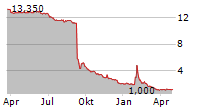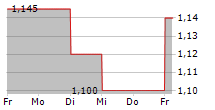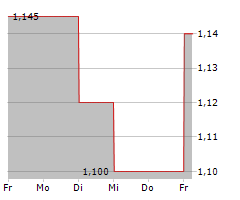
- The purpose of this pioneering Phase 2B trial was to show that AEF0117 reduces cannabis use and to determine the endpoints and optimal dosage to be used in future studies. AEF0117 is the first of a new pharmacological class, the CB1-SSi.
- AEF0117 was well-tolerated with no safety concerns identified, notably, AEF0117 did not cause the psychiatric side effects (e.g., anxiety, depression and suicidality) induced by the current CB1-antagonists that are not signalling specific.
- In the overall study population, the highest dose of AEF0117 (1mg) induced a non-statistically significant increase in the proportion of responders (+100% vs placebo) reaching the primary endpoint (cannabis use =1 day per week) and achieving abstinence (+200%). AEF0117 1mg also reduced the number of days of cannabis use per week, an effect that increased over time and was highest and close to statistical significance during the last month of treatment (-16% vs placebo; P=0.077).
- In the subgroup of patients (24%) with a high commitment to quit their cannabis use (measured by the Motivation to quit ladder), the effects of AEF0117 1mg were amplified for the primary (cannabis use =1 day per week) and secondary (abstinence and cannabis use =2 days per week) qualitative endpoints (+228% vs placebo in all cases) and for the number of days of cannabis use (-55% vs placebo; P=0.038) as well as for the amount of cannabis smoked per day (-76% vs placebo; P=0.029).
- The decrease in cannabis use induced by AEF0117 1mg is consistent across studies. Thus, when the data of the Phase 2B are analysed in a population of patients similar to the one of the previous Phase 2A, i.e. patients with moderate CUD, comparable and statistically significant reductions in cannabis use were found.
- These findings confirm that AEF0117 is safe, pharmacologically active and able to reduce cannabis use, validating the new CB1-SSi pharmacological class. They also indicate that future studies should explore higher doses of AEF0117 over longer treatment periods in patients highly motivated to reduce their cannabis consumption.
Regulatory News:
Two videoconferences will be held tomorrow, March 27, 2025
in French at 05:30pm CET and in English at 07:30pm CET (02:30pm ET)
To participate, please register here:
Videoconference in French
Videoconference in English
Aelis Farma (ISIN: FR0014007ZB4 Ticker: AELIS), is a clinical-stage biopharmaceutical company specializing in the development of treatments for brain and peripheral diseases.
In September 2024, Aelis Farma released preliminary results from the Phase 2B trial with AEF0117. AEF0117is the first of a new pharmacological class named the Signalling Specific inhibitors of the CB1 receptor of the endocannabinoid system (CB1-SSi). Although AEF0117 did not show a statistically significant effect on the primary endpoint, encouraging trends were observed demonstrating AEF0117's pharmacological activity and safety. After analysis of the preliminary results, Indivior PLC has communicated that it did not intend to exercise the option it had acquired for a global licence of AEF0117.
Aelis Farma has pursued its quality control process and conducted further analysis of the phase 2B data. Aelis Farma today announces the final analysis of its Phase 2B clinical trial with AEF0117 in patients with cannabis use disorders (CUD). These updated results will be the ground to engage in new partnership discussions allowing to move forward the development of AEF0117.
- Study Characteristics
This pioneering Phase 2B trial aimed to show that AEF0117 reduces cannabis use and to identify the endpoints and optimal dosage of AEF0117 for use in future studies.
The randomized, double-blind, placebo-controlled, 4-arm, parallel-group, prospective, multicenter study ("Effect of AEF0117 on Treatment-seeking Patients with Cannabis Use Disorder (CUD) (SICA2)"1) was conducted across eleven U.S. clinical centers, with 333 participants with moderate (19%) and severe (81%) CUD using cannabis =5 days/week at baseline. Participants were treated once daily for 12 weeks. The main groups were AEF0117 0.3mg (n=91), AEF0117 1mg (N=91) and placebo (n=90). A smaller group (n=61) received a presumed minimal effective dose of AEF0117 (0.1 mg). This group was to be analyzed if both the 0.3 and 1mg doses showed significant effects. As this condition was not fulfilled, the analysis focused on the placebo, 0.3 and 1mg AEF0117 groups.
In this study, both qualitative and quantitative endpoints were used to measure cannabis use. Qualitative endpoints measured the proportion of patients reaching a predefined threshold of cannabis use: 1. proportion of patients using cannabis 1 day per week (primary endpoint); 2. the proportion of patients achieving completed abstinence; 3. the proportion of patients using cannabis 2 days per week. The quantitative endpoints measured the number of days of cannabis use per week and the amount of cannabis smoked per day of use, assessed by the dollars spent to purchase cannabis. Additionally, the creatinine-normalized urine levels of the THC metabolite, THC-COOH, an objective measure of cannabis use, and changes in quality of life (Promis-29 scale) were measured at the end of treatment. Safety and tolerability were also assessed throughout the study.
- Results in the Overall Population of the Study
In the global population of the study, AEF0117 was safe and well tolerated with no safety concern identified, the frequency and type of adverse effect was similar across treatment groups.
AEF0117 1mg showed a non-statistically significant increase in the proportion of patients reaching the primary endpoint. Specifically, 4.4% of patients in the AEF0117 1mg group reduced their cannabis use to =1 day per week, compared to 2.2% in the placebo group (+100% vs placebo). Similarly, the proportion of patients achieving complete abstinence was 3.3% in the AEF0117 1mg group, compared to 1.1% in the placebo group (+200% vs placebo). AEF0117 1mg induced a smaller increase (+25% vs placebo) in the proportion of patients reducing cannabis use to =2 days per week. It has to be noted that the proportion of patients reaching the primary endpoint and the qualitative secondary endpoints in the placebo group is considerably lower than the one observed in previous studies published by academic groups.
AEF0117 1mg also progressively reduced the number of days of cannabis use per week, with the highest effect observed during the last month of treatment during which the placebo group had a mean of 6.1±0.36 days of use per week and the AEF0117 1mg group 5.1±0.04, representing a 16% decrease compared to placebo (P=0.077). A smaller trend was observed for the dollars spent on cannabis per day of use with the placebo group spending $15.1±1.84 and the AEF0117 1mg group spending $13.4±2.03, corresponding to a 11% reduction compared to placebo. No relevant differences were observed in the urine levels of THC-COOH at the end of treatment.
Finally, AEF0117 1mg induced a non-statistically significant trend toward an improvement in quality of life, as measured by the Promis-29 scale, as shown by a larger decrease in negative symptoms (-16.8±3.1) compared to placebo (-11.8±3.4), corresponding to a 30% reduction vs placebo. AEF0117 1mg also demonstrated favorable effects on specific behaviors that are negatively impacted in CUD and by CB1 antagonists. At the end of treatment AEF0117 1mg showed a trend to reduce anxiety (Placebo=4.0±0.44; AEF0117 1mg=2.8±0.44; P=0.057, and depression (Placebo= 3.9±0.40; AEF0117 1mg=3.2±0.39; P=0.181), did not induce any suicidal ideations or suicide-related behaviors as measured by the Columbia-Suicide Severity Rating Scale (C-SSRS, 0 score in all items of the scale) and did not modify sleep as measured by the Medical Outcome Study Sleep Scale (MOS-SS; Placebo= 355.4±5.31; AEF0117=364.2±5.2; P=0.24).
- Results in the Subpopulation of Patient with High Commitment to Quit Cannabis Use
In this study, a minority of the patients (24%) exhibited a high commitment to quit their cannabis use, as measured by the Motivation to Quit ladder at baseline. In this subgroup, compared to the overall population, AEF0117 1mg induced a larger increase in the proportion of patients reaching the qualitative primary and secondary endpoint (in all cases: Placebo=3.6%; AEF0117 1mg= 11.8%; +228% vs placebo; P=0.29). In parallel, AEF0117 induced over the last month of treatment a statistically significant reduction in the number of days of cannabis use per week (Placebo=5.8±0.76; AEF0117 1mg=2.6±1.33; 55% decrease vs placebo; P=0.038) and in the amount of the dollars spent on cannabis per day of use (Placebo=$24.9±3.5; AEF0117 1mg=$6.0±7.5; 76% decrease vs placebo; P=0.029). Although not statistically significant, a similar trend was observed for THC-COOH levels (Placebo= 959.1 ng/ml; AEF0117 1mg= 475.7 ng/ml, -50 vs placebo) as well as for the decrease in negative symptoms measured by the Promis-29 quality of life scale (Placebo=-11.1 ±7.35; AEF0117 1mg =-28.6 ±5.57, -61% vs placebo).
- Comparison of the Results of the Phase 2B with the Ones of the Previous Phase 2A
In the previous Phase 2A study2 with AEF0117, which included 80% of participants with a CUD mild or moderate, AEF0117 1mg induced a statistically significant reduction (P=0.025) in cannabis self-administration (47% reduction vs placebo). Since only 19% of the participants in the Phase 2B had moderate CUD, the remaining being severe, cannabis use per week was analyzed in this subpopulation of patients. In patients of the Phase 2B with moderate CUD, AEF0117 1mg progressively reduced the number of days of cannabis use per week (P=0.003), with the highest effect during the last month of treatment (Placebo=6.9±0.42, AEF0117 1mg=4.2±0.55, -39% vs placebo; P<0.001). These findings confirm the reproducibility of AEF0117's effects across studies.
- Key Takeaways from the Phase 2B Clinical Trial
First, quantitative endpoints are the most sensitive for measuring a decrease in cannabis use in CUD patients. While AEF0117 1mg had consistent but not statistically significant positive effects on qualitative measures of cannabis use, including the primary endpoint, statistically significantly reductions were observed on quantitative measures of cannabis use.
Second, the commitment of the patient to quit cannabis use is an important factor in determining the positive effects of AEF0117. Thus, in patients strongly committed to quit cannabis use (high score in the Motivation to Quit ladder), AEF0117 1mg induced consistent larger reduction in cannabis use than in the overall study population, a reduction reaching statistical significance for both the number of days of cannabis use per week and the dollars spent on cannabis per day of use.
Third, the reduction in cannabis use induced by AEF0117 is reproducible across studies. When analyzing data of the Phase 2B in a subgroup of participants similar to the one included in the Phase 2A (patients with a diagnosis of Moderate CUD), AEF0117 demonstrated comparable reductions in cannabis use.
Pr. Frances Levin, the study's principal investigator and Professor of Psychiatry at Columbia University, comments: "These results mark an important step forward in the treatment of Cannabis Use Disorder, a condition with no approved therapeutic solutions. We have compelling clinical evidence demonstrating the safety and potential efficacy of a pharmacologic approach in reducing cannabis use among participants with severe cannabis use disorder who express a strong desire to quit their marijuana use. This study not only supports AEF0117's potential but also provides a roadmap for future clinical and regulatory development. I extend my deepest gratitude to my team and all the clinical centers involved in this landmark study. Conducting this large and rigorous study was an ambitious challenge, and it was met with dedication and expertise. Through this collective effort, we have built a strong foundation of knowledge and infrastructure that will allow the conduct of future trials with lessons learned -- bringing us one step closer to delivering an effective treatment for patients struggling with cannabis addiction."
- General Conclusions and Future Perspectives
First, the data collected so far with AEF0117 provide a strong validation of the new CB1-SSi pharmacological class developed by Aelis Farma. AEF0117 is consistently pharmacologically active and reduces cannabis use across studies. AEF0117 is also well tolerated, did not induce any suicidal ideation and seems to have beneficial effects on anxiety and depression three symptoms that are increased by CB1 antagonists.
Second, to fully assess the therapeutic potential of AEF0117, doses higher than the highest one of the Phase 2B (1mg) should be tested over longer treatment periods. The highest reductions in cannabis use induced by AEF0117 were observed at 1mg during the last month of treatment, suggesting that a longer treatment period at higher doses could enhance efficacy.
Third, future studies should include only patients with a high commitment to strongly decrease or quit cannabis use.
Pier Vincenzo Piazza, CEO of Aelis Farma, concludes: "I wish to thank all the teams at Aelis Farma and the clinical centers for their remarkable work in conducting this pioneer study, the largest in the field of CUD. We now have a comprehensive understanding of the effects of AEF0117, confirming both its safety and pharmacological efficacy in reducing cannabis use. These results have also allowed to identify the appropriate population, endpoints and doses to be used in future clinical studies. The consistent efficacy and safety of AEF0117 found in animal models up to clinical trials also provide a strong scientific validation of the CB1-SSi, the innovative pharmacological class developed by Aelis Farma. We remain fully committed to identify the partnership and regulatory options that will allow to pursue AEF0117 development, and to deliver a much-needed solution for cannabis addiction-an increasingly prevalent and concerning global health concern."
About AELIS FARMA
Founded in Bordeaux in 2013, Aelis Farma is a biopharmaceutical company that is developing a new class of drugs, the Signaling Specific inhibitors of the CB1 receptor of the endocannabinoid system (CB1-SSi). CB1-SSi have been developed by Aelis Farma based on the discovery of a natural regulatory mechanism3 of CB1 hyperactivity made by the team led by Dr Pier Vincenzo Piazza, the Company's CEO, when he was the director of the Neurocentre Magendie of INSERM in Bordeaux. By mimicking this natural mechanism, CB1-SSi appear to selectively inhibit the disease-related activity of the CB1 receptor without disrupting its normal physiological activity. CB1-SSi have consequently the potential to provide new safe treatments for several brain and peripheral organ diseases.
Aelis Farma currently has two first-in-class clinical-stage drug candidates. AEF0117 for the treatment of cannabis use disorders (CUD), that has shown to be able to decrease cannabis use across two studies. AEF0217 for cognitive disorders, which has shown in a Phase 1/2 to be safe and able to improve adaptive behaviour in young adults with Down syndrome (Trisomy 21). The clinical results obtained with these 2 compounds have confirmed the safety and therapeutic activity of CB1-SSi in humans. The Company also has a portfolio of new innovative CB1-SSi for the treatment of other disorders associated with a dysregulation of the activity of the CB1 receptor, including diseases involving peripheral organs, such as obesity and related metabolic conditions. The different drugs developed by the company belong to the same general pharmacological class, the CB1-SSi, but have distinct functional effects allowing to target different types of dysregulations of the CB1 receptor and guaranteeing that the different compounds are not substitutable one with the others.
Aelis Farma draws on the talents of more than 25 highly qualified employees.
For more information, visit www.aelisfarma.com and follow us on LinkedIn and Twitter.
Upcoming communication:
- 2024 financial results: April 1, 2025 (after market close)
References:
- National Library of Medicine (U.S.) (2022, April). Effect of AEF0117 on treatment-seeking patients with cannabis use disorder (CUD) (SICA2). Identifier: NCT05322941 https://www.clinicaltrials.gov/study/NCT05322941
- Haney M, Vallée M, Fabre S, Collins Reed S, Zanese M, Campistron G, Arout CA, Foltin RW, Cooper ZD, Kearney-Ramos T, Metna M, Justinova Z, Schindler C, Hebert-Chatelain E, Bellocchio L, Cathala A, Bari A, Serrat R, Finlay DB, Caraci F, Redon B, Martín-García E, Busquets-Garcia A, Matias I, Levin FR, Felpin FX, Simon N, Cota D, Spampinato U, Maldonado R, Shaham Y, Glass M, Thomsen LL, Mengel H, Marsicano G, Monlezun S, Revest JM, Piazza PV. Signaling-specific inhibition of the CB1 receptor for cannabis use disorder: Phase 1 and Phase 2a randomized trials. Nat Med. 2023 Jun;29(6):1487-1499. https://doi.org/10.1038/s41591-023-02381-w
- Vallée M, Vitiello S, Bellocchio L, et al. Pregnenolone Can Protect the Brain from Cannabis Intoxication. Science 2014;343(6166):94-98. DOI: doi:10.1126/science.1243985
ISIN: FR0014007ZB4
Ticker: AELIS
B Compartment of Euronext Paris
Disclaimer
Forward-looking statements
Some information contained in this press release are forward-looking statements, not historical data. These forward-looking statements are based on current beliefs, expectations, and assumptions, including, but not limited to, assumptions about Aelis Farma's current and future strategy and the environment in which Aelis Farma operates. They involve known and unknown risks, uncertainties, and other factors, which may cause actual results, performance, or achievements, or industry results or other events, to differ materially from those described or implied by such forward-looking statements. These risks and uncertainties include those set out and described in detail in Chapter 3 "Risk Factors" of Aelis Farma's Universal Registration Document approved by the Autorité des Marchés Financiers on April 24, 2024, under number R.24-004.
These forward-looking statements are made only as of the date of this press release and Aelis Farma expressly disclaims any obligation or undertaking to release any updates or corrections to the forward-looking statements included in this press release to reflect any change in expectations or events, conditions, or circumstances on which any such forward-looking statement is based. Forward-looking information and statements are not guarantees of future performance and are subject to various risks and uncertainties, many of which are difficult to predict and generally beyond Aelis Farma's control. Actual results could differ materially from those described in, or implied or projected by, forward-looking information and statements
View source version on businesswire.com: https://www.businesswire.com/news/home/20250326193712/en/
Contacts:
AELIS FARMA
Pier Vincenzo Piazza
Chief Executive Officer
contact@aelisfarma.com
NewCap
Dusan Oresansky Aurélie Manavarere
Investor Relations
aelis@newcap.eu
+33 1 44 71 94 92
NewCap
Arthur Rouillé
Media Relations
aelis@newcap.eu
+33 1 44 71 00 15



